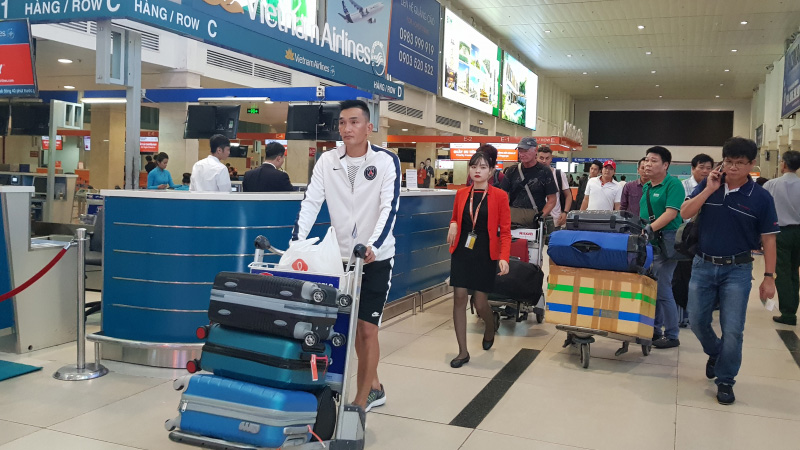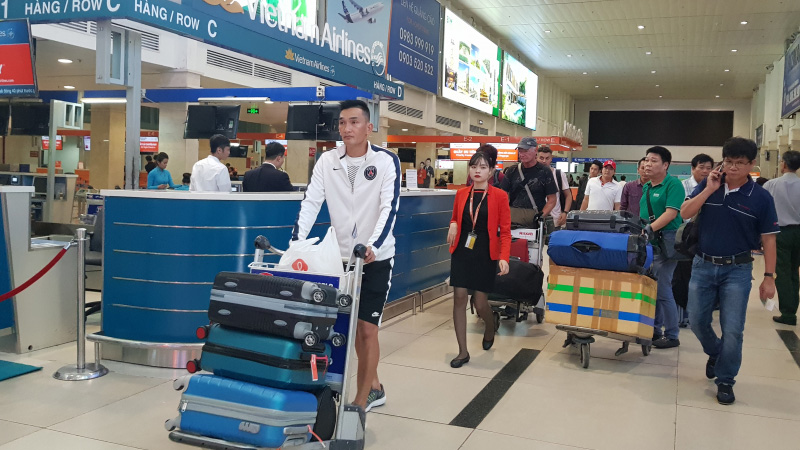
Vietnam expects to receive more than 112 million passengers through airports in the country in 2019, or 8 million people higher than the previous year, the Airports Corporation of Vietnam (ACV) has said.
Passengers at Tan Son Nhat
International Airport (Photo: mt.gov.vn)
The plan is made based on a
robust socio-economic outlook with GDP growth forecast at 6.6-6.8 percent as
well as a bright prospect on Vietnamese transportation market expansion.
The Airports Council International (ACI) forecasts the Vietnamese aviation
transportation to top the group of markets with more than 50 million passengers
a year during 2016-2040. Meanwhile, the International Air Transport Association
(IATA) predicts Vietnam as the world’s 5th fastest growing aviation market,
which will transport 150 million passengers by 2035, a representative from the
ACV said.
In 2019, the ACV will continue boosting investments and upgrades in airport
infrastructure, and mobilising resources for construction and development of
strategic airports like Long Thanh International Airport in southern Dong Nai
province. Furthermore, due attention will be paid to IT application into
airport management and operation in line with international standards.
Expansion of aprons will be made at busy airports like Noi Bai, Tan Son Nhat,
Da Nang, Cam Ranh, Lien Khuong, Cat Bi, Vinh and Phu Bai.
The ACV is making preparation for its key projects, including construction of
Terminal 3 at Tan Son Nhat International Airport, new terminals at Da Nang and
Cam Ranh International Airports, expansion of Terminal 2 at Noi Bai
International Airport, and Terminal 2 at Cat Bi, Vinh, Phu Bai, Dong Hoi and
Tho Xuan International Airports.
According to the corporation’s report, the ACV’s revenue in 2018 was estimated
at 17.84 trillion VND (768.27 million USD), surpassing the set plan by 11 percent,
and rising 18 percent against 2017.
At present, the Vietnamese aviation market has the participation of 68 foreign
airlines from 25 countries and territories and the four local carriers Vietnam
Airlines, Vietjet Air, Jetstar Pacific Airlines and Vasco.
The 68 foreign and three of the Vietnamese carriers (except Vasco) operate
nearly 130 international routes linking Hanoi, HCM City, Da Nang, Nha Trang,
Phu Quoc and Hai Phong with 28 countries and territories around the world.
Meanwhile, the four local airlines are running 48 domestic routes from Hanoi,
HCM City and Da Nang to 18 local airports.
Source: VNA
With an increasingly vibrant and widespread emulation movement aimed at building cultured residential areas and cultured families, Yen Thuy District has been making steady progress toward improving both the material and spiritual well-being of its people, while fostering a civilized, prosperous, beautiful, and progressive community.
Once lacking recreational spaces and community facilities, Residential Group 2 in Quynh Lam Ward (Hoa Binh City) has recently received attention for the construction of a new, spacious, and fully equipped cultural house. The project followed the model of state support combined with public contributions in both labor and funding.
The "All people unite to build cultural life" movement, which has been effectively integrated with Kim Boi district’s socio-economic development goals, is fostering a lively spirit of emulation across local residential areas, hamlets, villages, public agencies, and enterprises. In addition, through the initiative, traditional cultural values are being preserved and promoted, while community solidarity and mutual support in poverty reduction and economic development are being strengthened.
A working delegation of the Hoa Binh provincial People’s Committee led by its Permanent Vice Chairman Nguyen Van Toan on June 11 inspected the progress of a project to build the Mo Muong Cultural Heritage Conservation Space linked to tourism services in Hop Phong commune, Cao Phong district.
Born and growing in the heroic land of Muong Dong, Dinh Thi Kieu Dung, a resident in Bo town of Kim Boi district, in her childhood was nurtured by the sweet lullabies of her grandmother and mother. These melodies deeply imprinted on her soul, becoming an inseparable part of her love for her ethnic group's culture. For over 20 years, this love for her hometown has driven Dung to research, collect, and pass down the cultural values of the Muong people to future generations.
In the final days of May, the Ethnic Art Troupe of Hoa Binh Province organized performances to serve the people in remote, mountainous, and particularly disadvantaged areas within the province. These were not just ordinary artistic shows, but they were the meaningful journeys aimed at spreading cultural values, enhancing the spiritual life of the people and contributing to the preservation of ethnic minority cultural identities.



